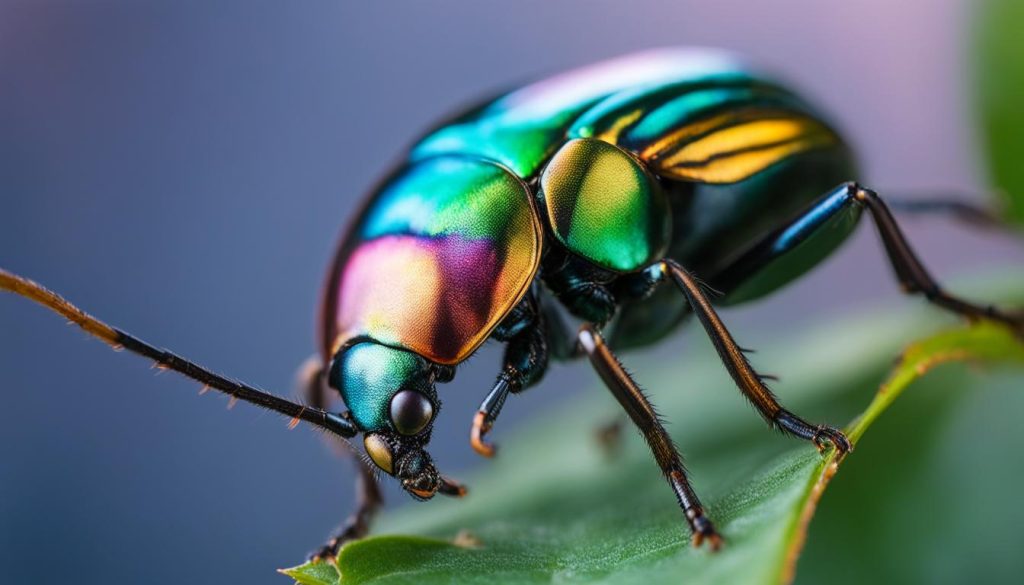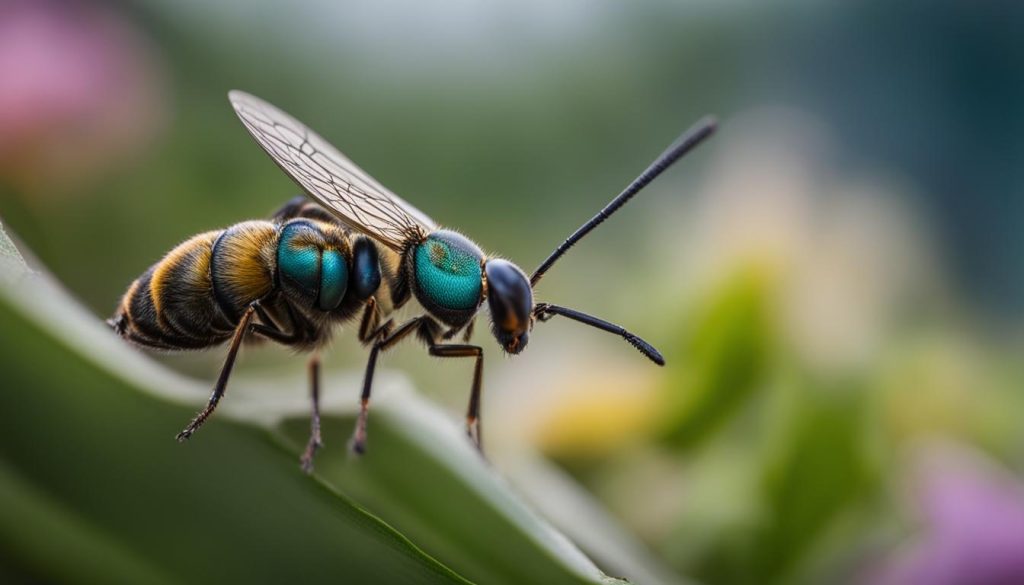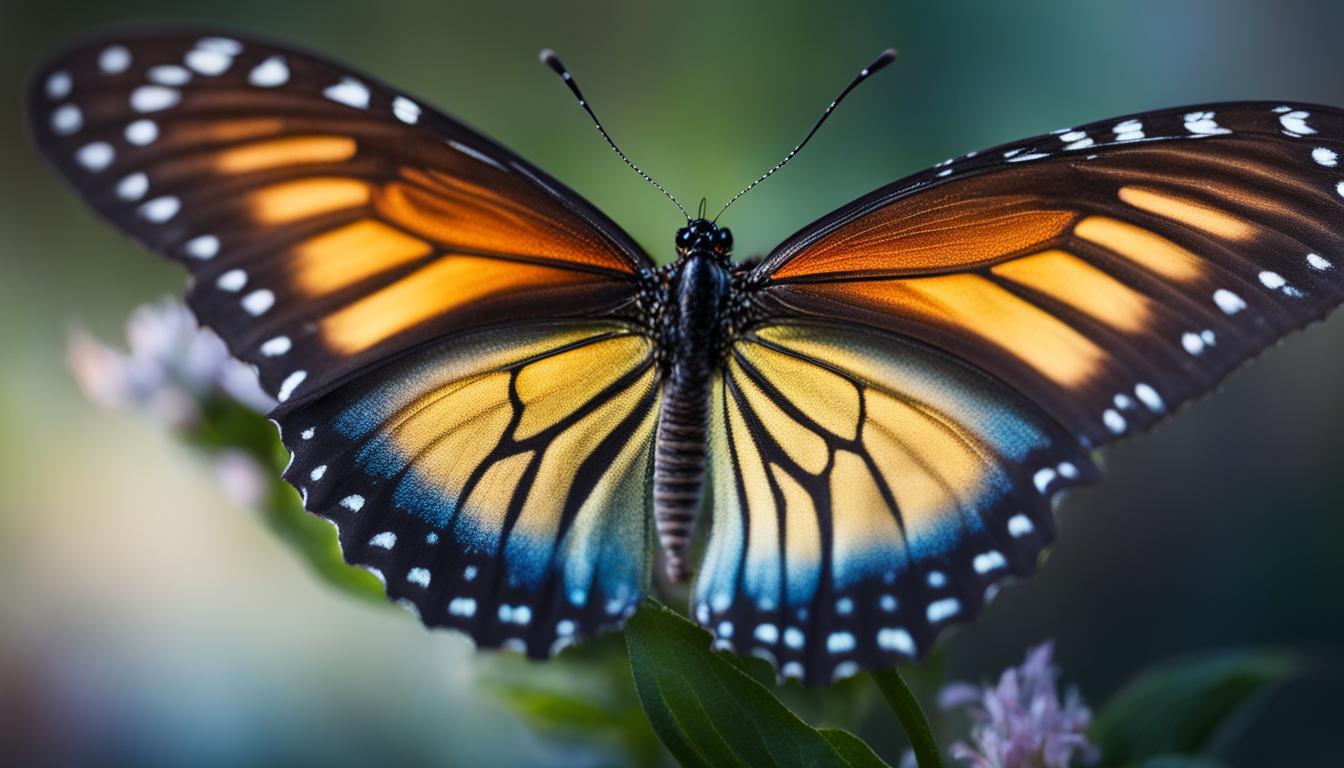Welcome to the fascinating world of macro photography, where we delve into the intricate and mesmerizing realm of insects. This unique form of photography allows us to capture the tiny details of these creatures and reveal a world that often goes unnoticed by the naked eye.
Macro photography involves getting up close and personal with our subjects, enabling us to see their world on a life-size scale. Through specialized lenses and techniques, we can uncover the hidden beauty and intricate structures of insects, unveiling a world that is as captivating as it is small.
By exploring the art of macro photography, we can unlock a creative outlet that allows us to see insects in a whole new light. From the delicate patterns on wings to the intricate colors and textures of their bodies, macro photography invites us to appreciate the beauty and wonder that exists in the tiniest of creatures.
Key Takeaways
- Macro photography offers a close-up view of the tiny world of insects.
- Specialized lenses and techniques are used to capture life-size details.
- Macro photography allows us to appreciate the hidden beauty of insects.
- It is an art form that invites creativity and a fresh perspective.
- Exploring macro photography can unveil the wonders of the miniature world.
The Equipment for Macro Photography
To embark on your macro photography journey, you’ll need the right equipment to capture stunning close-up shots. While a 50mm lens with a wide aperture can produce macro-like results, additional tools will enhance your images.
Close-up filters act as magnifying glasses that attach to your lens, allowing you to get closer to your subjects and achieve sharp image quality. However, keep in mind that these filters may cause slight image degradation at the edges.
If you’re looking for a method that doesn’t compromise image quality, consider extension tubes. These tubes are placed between your camera body and lens, enabling you to focus at a closer distance without any loss of image quality. With extension tubes, you can capture intricate details of tiny subjects with ease.
The most convenient option for macro photography is investing in a dedicated macro lens. These lenses, such as the Canon EF 100mm f/2.8L USM Macro Lens or the Nikon 60mm f/2.8D AF Micro, are specifically designed to capture macro images with edge-to-edge sharpness. They provide excellent optical quality and allow for precise focusing, making them ideal for capturing the fine details of insects and other small subjects.
Remember, having the right equipment will greatly enhance your macro photography experience and help you capture breathtaking close-up shots.
Brief Summary:
To get started with macro photography:
- Consider a 50mm lens with a wide aperture for macro-like shots.
- Use close-up filters to magnify your subjects, but be aware of potential image degradation at the edges.
- Opt for extension tubes to maintain image quality while getting closer to your subjects.
- Invest in a dedicated macro lens for optimal edge-to-edge sharpness, such as the Canon EF 100mm f/2.8L USM Macro Lens or the Nikon 60mm f/2.8D AF Micro.
| Lens | Features |
|---|---|
| Canon EF 100mm f/2.8L USM Macro Lens | – Dedicated macro lens with exceptional image quality – Offers 1:1 magnification for life-size reproduction – Ultrasonic Motor (USM) for fast and accurate autofocus – Built-in image stabilization for sharp handheld shots – Weather-sealed construction for durability |
| Nikon 60mm f/2.8D AF Micro | – Versatile macro lens with superb optical performance – Provides 1:1 magnification for true macro photography – Autofocus with Manual Priority (M/A) mode for quick adjustments – Super Integrated Coating minimizes flare and ghosting – Compact and lightweight design for easy portability |
The Art of Macro Photography
Macro photography is not just about the equipment; it is also an art form that requires a unique mindset and a creative approach. In this section, we will explore the various techniques and practices that can help photographers unleash their creativity and capture stunning macro images.
Developing a Different Perspective
One of the keys to successful macro photography is the ability to see things differently. Instead of merely capturing a subject as it appears, photographers should strive to find unique perspectives and compositions that bring out its hidden beauty. By exploring different angles, depths, and viewpoints, photographers can reveal captivating details that are often overlooked with the naked eye.
Experimenting with Creative Techniques
To add an artistic touch to macro photography, photographers can experiment with various creative techniques. Defocusing certain elements of the frame can create a dreamy effect, while multiple exposures can merge different moments and create dynamic compositions. Water droplets can be incorporated to add an element of interest and abstraction to the image. Additionally, selective focus can draw attention to specific details, highlighting the subject’s unique characteristics.
Observing the Subject and Composing the Shot
Before pressing the shutter, photographers should take the time to observe the subject closely. By studying the intricacies of the subject’s architecture, photographers can determine the best composition and framing for their shot. Factors such as depth of field, lighting, and color should also be considered to create visually appealing images.
Remember, macro photography allows for an immersive experience with the subject, so take the time to truly observe and understand it before capturing the shot.

Mastering the Technical Aspects
When it comes to macro photography, mastering the technical aspects is essential for achieving exceptional results. Understanding and effectively controlling key factors like depth of field, aperture, lighting, and color can make a significant difference in your macro images.
Depth of Field: Bringing Focus to the Forefront
An important consideration in macro photography is depth of field. It refers to the area of sharpness in your image, from the foreground to the background. By controlling the depth of field, you can determine which parts of your subject will be in focus and which will have a beautiful, soft background blur.
Experimenting with different aperture settings can help you achieve the desired effect. A wider aperture (smaller f-stop number) will result in a shallow depth of field, creating a more pronounced background blur and highlighting the main subject. Conversely, a smaller aperture (larger f-stop number) will increase the depth of field, keeping more of the image in focus.

Lighting: Illuminating the Miniature World
Proper lighting is crucial in macro photography, as it can enhance the details, textures, and colors of your subject. Understanding the characteristics of light, such as its quality, direction, and reflection, can help you create visually captivating images.
Experiment with different lighting setups to find what works best for your subject. Natural light can provide a soft and diffused illumination, while artificial lighting options like ring lights or off-camera flashes can offer more control and flexibility. Reflectors can also be used to bounce light and reduce shadows, ensuring even lighting across your subject.
Color: Adding Visual Impact and Mood
Color plays a vital role in macro photography, allowing you to capture the nuances and intricacies of your subject’s palette. It can evoke emotions, create mood, and add visual impact to your images.
Consider the color scheme and choose complementary or contrasting colors to make your macro photographs stand out. Experiment with different lighting conditions to see how they affect the colors in your images. In post-processing, you can further enhance the colors to make them pop or create a specific atmosphere.
Remember, mastering the technical aspects of macro photography takes practice and experimentation. By understanding and controlling depth of field, playing with lighting techniques, and leveraging the power of color, you can elevate your macro images to new heights of creativity and visual appeal.
Conclusion
Macro photography offers a captivating glimpse into the extraordinary world of insects, allowing us to appreciate their hidden beauty and intricate details. With the right equipment, such as dedicated macro lenses and accessories like extension tubes, photographers can bring these tiny creatures to life on a macro scale.
Mastering the technical aspects of macro photography, including understanding depth of field and playing with different apertures, enables photographers to create captivating images with a desired focus and background blur. And by adopting a creative mindset, photographers can explore various techniques, such as defocusing, multiple exposures, and selective focus, to capture visually stunning and unique compositions.
Lighting is another crucial factor in macro photography, and photographers can experiment with the different characteristics of light to enhance their images. Whether it’s utilizing the quality and direction of natural light or incorporating artificial lighting techniques, the interplay of light and color can add depth and mood to macro photographs.
So, whether you’re a seasoned professional or just starting your photographic journey, macro photography opens up a world of opportunities for creative expression. Through this unique lens, you can discover the mesmerizing world of insects and showcase their beauty in a way that often goes unnoticed. Expand your horizons, embrace your creative vision, and embark on an extraordinary macro adventure!
FAQ
What is macro photography?
Macro photography is a technique that allows photographers to capture extreme close-up views of subjects, such as insects, revealing details that are not visible to the naked eye.
How can I achieve macro shots?
To achieve macro shots, you can use specific lenses, close-up filters, extension tubes, or dedicated macro lenses. These tools help you get closer to your subjects and capture images with edge-to-edge sharpness.
What equipment do I need for macro photography?
For macro photography, you can opt for a 50mm lens with a wide aperture or invest in a dedicated macro lens. The Canon EF 100mm f/2.8L USM Macro Lens or the Nikon 60mm f/2.8D AF Micro are excellent options specifically designed for macro images.
How can I develop a creative approach in macro photography?
Developing a creative approach in macro photography involves the ability to see things differently and find unique perspectives and compositions. You can experiment with techniques like defocusing, multiple exposures, water droplets, abstraction, and selective focus to create visually engaging images.
What technical aspects should I focus on in macro photography?
Mastering depth of field and understanding how to control it is crucial in macro photography. Experimenting with aperture settings can help achieve the desired focus and background blur. Lighting is also important, and exploring the characteristics of light, such as quality, direction, and reflection, can enhance your macro images. Additionally, using color effectively can add visual impact and create mood in your photographs.
How can macro photography capture the hidden beauty of insects?
Macro photography offers a unique opportunity to explore the enchanting world of insects up close. By investing in the right equipment, mastering the technical aspects, and adopting a creative mindset, you can capture the intricacies and details that often go unnoticed, revealing the hidden beauty of insects through macro photography.






